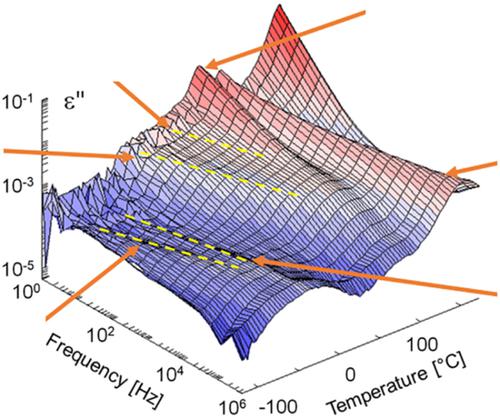当前位置:
X-MOL 学术
›
J. Polym. Sci.
›
论文详情
Our official English website, www.x-mol.net, welcomes your
feedback! (Note: you will need to create a separate account there.)
Transient dynamics of cold‐rolled and subsequently thermally rejuvenated atactic‐polystyrene using broadband dielectric spectroscopy
Journal of Polymer Science ( IF 3.9 ) Pub Date : 2020-06-21 , DOI: 10.1002/pol.20190068 Kalouda Grigoriadi 1, 2 , Michael Wübbenhorst 3 , Lambèrt C. A. Breemen 1 , Tristan Putzeys 3 , Alessia Gennaro 3 , Patrick D. Anderson 1 , Markus Hütter 1
Journal of Polymer Science ( IF 3.9 ) Pub Date : 2020-06-21 , DOI: 10.1002/pol.20190068 Kalouda Grigoriadi 1, 2 , Michael Wübbenhorst 3 , Lambèrt C. A. Breemen 1 , Tristan Putzeys 3 , Alessia Gennaro 3 , Patrick D. Anderson 1 , Markus Hütter 1
Affiliation

|
The effect of plastic deformation on the molecular dynamics of atactic polystyrene (a-PS) was studied by broadband dielectric relaxation spectroscopy (BDRS), Fourier-transform infrared spectroscopy (FTIR) and polarized-light microscopy. Sheets of a-PS have been subjected to cold rolling, that is, mechanical rejuvenation, followed by a quenching step and fast heating above its glass-transition temperature, resulting in thermal rejuvenation. Cold rolling revealed, in addition to the known α- and γ(I)-relaxations, four hitherto unknown relaxation processes (II, III, IV and V). Using the framework of craze formation and multiplicity of the glass transition (E. Donth, G. H. Michler, Colloid Polym. Sci. 1989, 267, 557–567), supported by an activation-enthalpy/entropy analysis (Starkweather, W. Howard, Macromolecules 1981, 14, 1277–1281), the following physical picture emerges: (a) processes I and II represent local conformation transitions γ referring to chains of two different degrees of stretching (T/G-ratio); and (ii) processes III and IV were identified as helix-inversion processes of T2G2 helices as reported earlier for syndiotactic-rich PS—an assignment supported by FTIR results. Finally, the relaxation V could be attributed to the onset of the fibrillar glass transition (within crazes), leading to stress release by collapse of the fibrils and hence dying out of process V. Polarized-light microscopy confirmed the creation of oriented structures and internal stresses upon cold rolling, and their removal upon thermal rejuvenation.
中文翻译:

使用宽带介电光谱研究冷轧和随后热再生的无规立构聚苯乙烯的瞬态动力学
通过宽带介电弛豫光谱 (BDRS)、傅里叶变换红外光谱 (FTIR) 和偏光显微镜研究了塑性变形对无规立构聚苯乙烯 (a-PS) 分子动力学的影响。a-PS 片材经过冷轧,即机械复原,然后进行淬火步骤并在其玻璃化转变温度以上快速加热,从而实现热复原。除了已知的 α- 和 γ(I)-弛豫之外,冷轧还揭示了四种迄今为止未知的弛豫过程(II、III、IV 和 V)。使用玻璃化转变的裂纹形成和多样性的框架 (E. Donth, GH Michler, Colloid Polym. Sci. 1989, 267, 557–567),由活化-焓/熵分析 (Starkweather, W. Howard,大分子 1981, 14, 1277–1281), 出现以下物理图片:(a)过程 I 和 II 表示局部构象转变 γ,涉及两种不同拉伸程度(T/G 比)的链;(ii) 过程 III 和 IV 被确定为 T2G2 螺旋的螺旋反转过程,如早先报告的富含间规的 PS——FTIR 结果支持的分配。最后,弛豫 V 可归因于原纤维玻璃化转变的开始(在裂纹内),通过原纤维的坍塌导致应力释放,从而在过程 V 中消失。偏光显微镜证实了定向结构和内部结构的产生冷轧时的应力,并在热再生时去除。(a) 过程 I 和 II 代表局部构象转变 γ,涉及两种不同拉伸程度(T/G 比)的链;(ii) 过程 III 和 IV 被确定为 T2G2 螺旋的螺旋反转过程,如早先报告的富含间规的 PS——FTIR 结果支持的分配。最后,弛豫 V 可归因于原纤维玻璃化转变的开始(在裂纹内),通过原纤维的坍塌导致应力释放,从而在过程 V 中消失。偏光显微镜证实了定向结构和内部结构的产生冷轧时的应力,并在热再生时去除。(a) 过程 I 和 II 代表局部构象转变 γ,涉及两种不同拉伸程度(T/G 比)的链;(ii) 过程 III 和 IV 被确定为 T2G2 螺旋的螺旋反转过程,如早先报告的富含间规的 PS——FTIR 结果支持的分配。最后,弛豫 V 可归因于原纤维玻璃化转变的开始(在裂纹内),通过原纤维的坍塌导致应力释放,从而在过程 V 中消失。偏光显微镜证实了定向结构和内部结构的产生冷轧时的应力,并在热再生时去除。
更新日期:2020-06-21
中文翻译:

使用宽带介电光谱研究冷轧和随后热再生的无规立构聚苯乙烯的瞬态动力学
通过宽带介电弛豫光谱 (BDRS)、傅里叶变换红外光谱 (FTIR) 和偏光显微镜研究了塑性变形对无规立构聚苯乙烯 (a-PS) 分子动力学的影响。a-PS 片材经过冷轧,即机械复原,然后进行淬火步骤并在其玻璃化转变温度以上快速加热,从而实现热复原。除了已知的 α- 和 γ(I)-弛豫之外,冷轧还揭示了四种迄今为止未知的弛豫过程(II、III、IV 和 V)。使用玻璃化转变的裂纹形成和多样性的框架 (E. Donth, GH Michler, Colloid Polym. Sci. 1989, 267, 557–567),由活化-焓/熵分析 (Starkweather, W. Howard,大分子 1981, 14, 1277–1281), 出现以下物理图片:(a)过程 I 和 II 表示局部构象转变 γ,涉及两种不同拉伸程度(T/G 比)的链;(ii) 过程 III 和 IV 被确定为 T2G2 螺旋的螺旋反转过程,如早先报告的富含间规的 PS——FTIR 结果支持的分配。最后,弛豫 V 可归因于原纤维玻璃化转变的开始(在裂纹内),通过原纤维的坍塌导致应力释放,从而在过程 V 中消失。偏光显微镜证实了定向结构和内部结构的产生冷轧时的应力,并在热再生时去除。(a) 过程 I 和 II 代表局部构象转变 γ,涉及两种不同拉伸程度(T/G 比)的链;(ii) 过程 III 和 IV 被确定为 T2G2 螺旋的螺旋反转过程,如早先报告的富含间规的 PS——FTIR 结果支持的分配。最后,弛豫 V 可归因于原纤维玻璃化转变的开始(在裂纹内),通过原纤维的坍塌导致应力释放,从而在过程 V 中消失。偏光显微镜证实了定向结构和内部结构的产生冷轧时的应力,并在热再生时去除。(a) 过程 I 和 II 代表局部构象转变 γ,涉及两种不同拉伸程度(T/G 比)的链;(ii) 过程 III 和 IV 被确定为 T2G2 螺旋的螺旋反转过程,如早先报告的富含间规的 PS——FTIR 结果支持的分配。最后,弛豫 V 可归因于原纤维玻璃化转变的开始(在裂纹内),通过原纤维的坍塌导致应力释放,从而在过程 V 中消失。偏光显微镜证实了定向结构和内部结构的产生冷轧时的应力,并在热再生时去除。










































 京公网安备 11010802027423号
京公网安备 11010802027423号